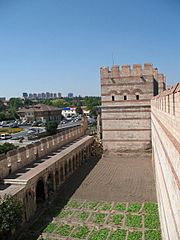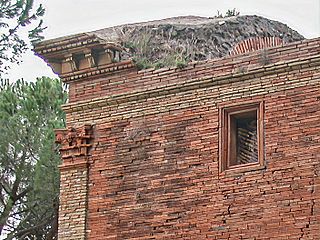Roman brick facts for kids
Roman brick is a special kind of brick used by the ancient Romans. They spread this way of making bricks to the places they conquered. Today, we also have modern bricks inspired by these old Roman ones. Both types are usually longer and flatter than the normal bricks we see today.
Contents
Ancient Roman Bricks
The Romans first started making fired clay bricks during the Roman Empire. Before that, they used mudbrick, which was just dried in the sun. Sun-dried mudbricks were much weaker and only good for smaller buildings.
How Romans Made Bricks
The Romans began making fired bricks around 13 BC, learning from the Greeks. The Greeks had been using fired bricks for a long time. One of the first buildings in Rome to use fired brick was the Theatre of Marcellus.
Making bricks in a kiln (a special oven) meant they wouldn't crack when they dried. Mudbricks took a very long time to dry, so bricks could only be made during certain seasons. Fired bricks allowed Romans to make many more bricks, much faster. This led to a huge increase in brick production across Rome.
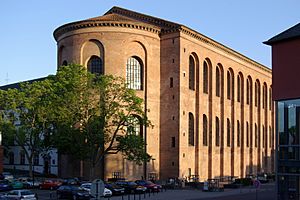

Shapes and Sizes of Roman Bricks
Roman bricks were almost always shorter than modern bricks. But they came in many different shapes and sizes! Some were square, rectangular, triangular, or even round. The biggest ones found were over three feet long.
A common size for ancient Roman bricks was about 1½ Roman feet by 1 Roman foot. This is roughly 17.5 inches by 11.5 inches. Other sizes included 24 inches by 12 inches by 4 inches. In France, Roman bricks measuring 8 inches by 8 inches by 3 inches have been found. The Constantine Basilica in Trier uses Roman bricks that are 15 inches square and 1½ inches thick.
Sometimes, it's hard to tell the difference between Roman bricks used for walls and tiles used for roofs or floors. Because of this, archaeologists often use the general term "Ceramic Building Material" (CBM) for all of them.
Roman Brickmaking Spreads
The Romans became experts at making bricks during the first century of their Empire. They used bricks everywhere, for both public and private buildings. Making so many bricks helped them build many public projects. Over time, the government took over the brick business, making it an imperial monopoly.
The Romans took their brickmaking skills with them wherever they went. Even the Roman legions (their armies) had mobile kilns. This meant they could make bricks in many parts of the empire. These bricks often had stamps on them from the legion that made them. These stamps help us know where and when the Roman military was active.
Famous buildings made with Roman brick include the Red Basilica in Pergamon, the Domus Tiberiana, and the Basilica of Maxentius in Rome. After the Romans left the British Isles, there was a gap of about 600-700 years before a lot of bricks were made there again.
Bricks in Roman Walls
When building with stone, Romans often added thin layers of bricks, called "bonding tiles," at regular spots. This made the structure stronger and more stable. It was especially helpful when building with uneven materials like flint, as the bricks helped to make the layers level. This also made the walls look colorful, with alternating patterns of stone and brick.
In the 1530s, an English expert named John Leland found Roman bricks in different places. He called them "Briton brykes" and could tell them apart from medieval and modern bricks by their size and shape. This was an early example of studying how ancient objects are different from newer ones.
Medieval Europe and Roman Bricks
After the Fall of the Western Roman Empire in the 5th century, many stone quarries in Europe were no longer used. People started reusing old Roman building materials, including Roman bricks. For example, in the 10th century, the abbots of St. Albans collected so many Roman bricks that they had their own large supply.
When people started making bricks again in the British Isles, the height of the Roman-style brick (1½ to 2 inches) slowly increased during the early Medieval period. Roman bricks were often reused in medieval Europe and even later. This happened all over the former Roman Empire. In Great Britain, where building materials were less common, Roman structures were taken apart for their stone and brick. You can see examples of this reuse in Anglo-Saxon churches like those at Brixworth, Corbridge, St. Martin's, Canterbury, and St Nicholas', Leicester.
Modern Roman Bricks
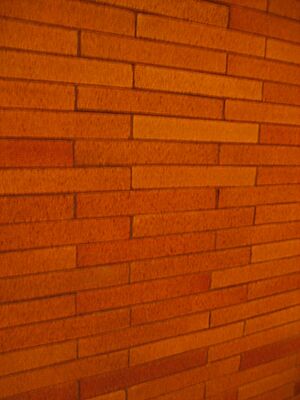
Modern "Roman" bricks first appeared in the early 1900s. They are always longer and flatter than other modern bricks, but they don't have one exact size. In the United States in the early 20th century, they were often about 4 inches by 2 inches by 12 inches. This gave them a 6:2:1 ratio, while most modern bricks have a roughly 4:2:1 ratio. Other sizes, like 16 inches by 6 inches by 4 inches, were also made.
Today, there are many types of bricks available. In 2011, a company called Roman Brick Company in Glasgow offered "Roman" bricks in different heights (40, 52, 65, or 71mm), widths (90 or 115mm), and lengths (290, 365, 440, 490, and 600mm).
The architectural firm McKim, Mead, and White brought Roman bricks to the United States. At one time, Roman brick was one of only three types of bricks available there. By 1920, there were at least five types of bricks for builders and architects to choose from.
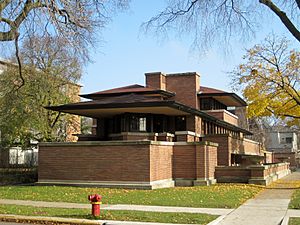
The famous architect Frank Lloyd Wright used Roman brick in his design for the Robie House in Chicago. He liked to use them in many of his Prairie style homes. For the Robie House, Wright chose a brick called "Pennsylvania Iron Spot Roman brick." He even traveled to St. Louis himself to pick it out.
Wright used Roman brick to highlight the horizontal (side-to-side) lines that were common in his Prairie style buildings. He made these horizontal lines stand out even more by using mortar (the cement between bricks) that was recessed and a different color. The vertical (up-and-down) mortar lines were made less noticeable by making them flush with the brick and the same color.
Today, it can be hard to find Roman bricks for people who want to restore and preserve Wright's buildings.
Ancient Roman Brick Stamps
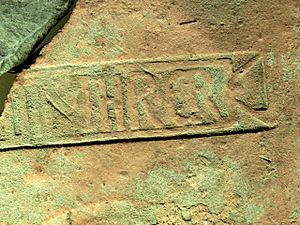
Around the middle of the 1st century BC, Roman brick makers started putting unique stamps on their bricks. The first stamps were simple. They usually just had the name of a person and sometimes the name of the brickyard where the brick was made. These early stamps were pressed into the wet clay using a wooden or metal mold before the brick was fired.
As the early Roman Empire grew, fired brick became the main building material. More and more wealthy landowners started making bricks from clay on their land. So, the brick stamps became more complex, with many different names appearing on them. In 110 AD, the stamps started including the names of the consuls for that year. This helps experts today know exactly when a brick was made.
At first, people didn't think much of these brick stamps. But now, they are very important for archaeologists. They help scholars learn about the demand for bricks in Ancient Rome. By looking at the dates on the stamps, they can create a timeline of brick production. Today, every time a brick stamp is found, it is carefully recorded. This information, along with where the brick was found, helps us accurately date ancient Roman buildings. Brick stamps have also helped us understand the general timeline of Ancient Rome.
Ancient Roman Brickyards
Most Roman bricks were made at special places called brickyards. These brickyards were usually on large estates owned by rich families who had access to clay. There was a clear system for making bricks:
- The domini were the owners of the estate, usually rich aristocrats.
- The officinatores were usually middle-class people who supervised the brick-making process.
- The figlinae were usually slaves who actually made the bricks.
Men, women, and children all played different roles in these groups. The brick stamps gave credit to the domini, officinatores, the brickyard, and the consuls of the time. There were rules about how many bricks could be made in a day. If more were made than allowed, those extra bricks became public property.
A Roman brickyard owned by Domitia Calvilla, the mother of Emperor Marcus Aurelius, has been found near Bomarzo, about 40 miles north of Rome.
Images for kids
-
Roman brick factory in Germany, near the Roman provincial capital of Augsburg
-
The city walls of Constantinople, showing several courses of brickwork
-
A tomb on the Appian Way in Rome with Roman brickwork in opus latericium





